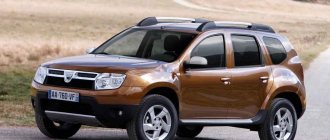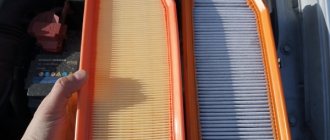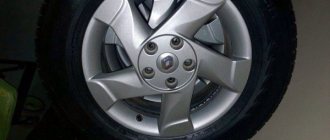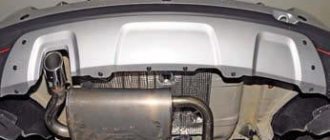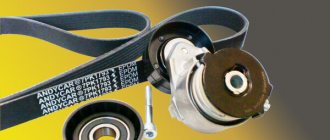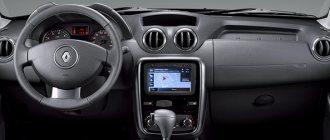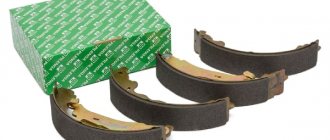What to choose: Duster or Shnivy?
When buying a Chevrolet Niva, you pay for permanent all-wheel drive and the ability to crawl off-road.
But you don’t need to think that the Shniva can give you complete independence from the asphalt; the very weak engine, which loses half of its power in the transfer case, turns climbing up hills into muddy roads into a lottery; you might finish it, but you might have to roll back, closing your eyes for fear. Renault Duster is also far from an SUV, but ask yourself a question: how often do you overcome off-road conditions in its full sense? Everyone has their own answer to this question.
https://www.youtube.com/watch?v=VPkpmfplxAA
Therefore, the choice should be made based on personal preferences in comfort and depending on the halo of the car’s habitat during operation.
I hope my advice is useful to you. See you later!
PS Here you can read the Renault Duster test drive, which took place in Romania, at this link
Exterior appearance of renault duster and chevrolet niva
Both cars are in the budget class, which, one way or another, is reflected in their appearance.
However, Renault Duster looks much more attractive and modern. However, this is not surprising if we remember that the design of the Chevrolet Niva has remained virtually unchanged since 2002. But let's look at the exterior in more detail.
In 2021, Renault Duster underwent a planned restyling, during which the car received new front and rear optics, a modified false radiator grille and a more stylish plastic body kit.
The crossover profile sports blown wheel arches, a large glass area and roof rails. External dimensions of Renault Duster:
- length – 4.315 m;
- width – 1.822 m;
- height – 1.625 m;
- wheelbase length - 2.673 m.
Compared to the “French” model, the Chevrolet Niva looks a bit boring, and this despite the fact that the SUV underwent its last update in January of this year.
The “face” of the car is greeted by large head optics, a neat false radiator grille and a laconic front bumper, while the rear flaunts a hinged tailgate and laconic vertically positioned side lights.
The car's profile captivates with large wheel arches and a wide plastic trim that reliably protects the lower part of the side doors from damage. The external dimensions of the domestic “American” have the following parameters:
- length – 4.056 m;
- width – 1.8 m;
- height – 1.652 m;
- wheelbase - 2.45 m.
The Renault Duster's ground clearance is 205 and 210 mm for the front-wheel drive and all-wheel drive versions, respectively, but the Chevrolet Niva's ground clearance is noticeably higher - 240 mm, which allows one to count on better geometric cross-country ability.
Two old men. comparison of lada 4×4 and chevrolet niva - magazine {amp}quot;autobroker{amp}quot;
Autumn is coming to an end - it's time to put some dirt on your SUV.
If you have one, of course. And if you are not quite old enough for such rides. In the fall of 2021, the editorial office found itself with several all-wheel drive vehicles. A couple can be called old people, these are Lada 4x4 and Chevrolet Niva. There was also a Renault Duster, which we conducted a comparative test with the Chevrolet Niva in company with bloggers from Simple Opinion.
We were faced with a simple task, to understand how the “regular Niva” differs from the Chevrolet Niva. After all, it’s worth admitting that if you want to buy a practical all-wheel drive car without mileage, costing no more than 850,000 rubles, you will still consider both options, often not finding a fundamental difference. And she is.
A short excursion into the past
Both cars are the development of AvtoVAZ, dating back to the last century. The Chevrolet Niva is an advanced version of the VAZ Niva (Niva-2 project, model 2123), transferred to the Russian-American joint venture GM-AVTOVAZ (not to be confused with AvtoVAZ) in 2001.
The period 2020-2020 became that segment of the car life cycle when all possible latest changes were introduced that did not require expensive interventions in the body, platform, exterior, interior and power units. Cars have been modernized before.
The Chevrolet Niva was different in some ways from the very beginning, something, usually faster than its progenitor, was introduced year after year. Changes in the two cars mostly concern environmental standards, individual engine and timing components, transfer case, reduction of vibrations and noise, and chassis.
The engine and transmission, apart from minor differences in details, are the same. The interior and some exterior details were changed point by point. The engines and transmission remained unchanged, although engineers also dug into them. And here in front of us are two almost identical, almost Russian SUVs.
Driving sensations
Before we get behind the wheel of a car, we inevitably see it. Sometimes it hurts. Immediately the visual impressions are the same. Not to say that either of them is too scary, but neither of them shine with beauty and originality. Lada 4x4 has more brutal shapes. The Chevrolet is quite suitable for work trips, and after washing and hanging ribbons and balls, it’s not a shame to transport a wedding.
There is an order of magnitude more comfort in the Shnivy. This applies to absolutely everything - the seating position, with all the adjustments (there is even lumbar support), lower noise levels, the presence of touchscreen multimedia, and the overall ergonomics of the cabin. Excellent visibility, which is not hidden even by the snorkel, conveniently hidden behind the left front pillar. Quite adequate heating system. It is very warm in the Chevrolet Niva in winter.
As much as I would like to say something similar about the Lada 4×4, it’s impossible. Everything in the cabin is absolutely budget-friendly. The steering wheel is without adjustment, the heater unit with analog temperature and flow switches, which the current generation perceives as a set of hanger levers. Foreign-placed air conditioning controls... The gearshift lever, which you have to reach for when sitting moderately comfortably in your seat. And noise. Lots of noise.
The cars ride is soft, the suspension works great on bumps and when passing speed bumps. Here you get real pleasure. When driving on the highway, the Chevrolet Niva feels more confident. There is no longitudinal swing, which is due to a different weight distribution, a few centimeters of the wheelbase and changes in the suspension.
Offroad
There is not much difference here, if you do not take into account the presence of a snorkel in some Chevrolet trim levels and a different arrangement of components in the engine compartment - the spare tire is on the rear door, and not, like the Lada, under the hood.
Both Shniva and Niva fully justify the status of SUVs without having a frame, as ardent adherents of preserving terminology may recall to us.
The only difference that a driver who decides to play with the reduction gear and locks will encounter is that the Chevrolet, in addition to the gearbox selector, has one more lever, while the classic Niva has two. GM-AVTOVAZ has combined the functions of locking the center differential and controlling the reduction row, which is much more convenient to use and more aesthetically pleasing. All have permanent all-wheel drive.
We tested both cars on the same route, where we had driven a Duster two days earlier. Liquid mud up to the middle of the wheel, bumps hidden under water, dirt roads and sandy climbs cut by tree roots - this is not the off-road you want for maximum emotions. But these are the conditions in which these cars mostly live for decades.
Prices and options
You can buy a Chevrolet Niva in the showrooms of official dealers at prices ranging from 687,000 rubles for the L trim level, to 819,000 rubles for the maximum GLC. In total, the manufacturer offers 6 complete sets, differing in a cover or plastic spare tire box, heating and adjustments, the presence of some exterior and interior elements, multimedia, window tinting, wheels, a snorkel, the presence of roof rails and a standard tow bar.
The VAZ car has four trim levels - Classic for 523,900 rubles, with only front windows for comfort, this is the bare minimum. Black Edition is the maximum for a three-door car. For this they ask 579,900 rubles. And it has adjustable mirrors, air conditioning (also available on cheaper trim levels), a more fashionable combination, heated and heated mirrors and front seats, and light tinting. Neither a radio nor multimedia is included in any of the configurations. Audio preparation only.
Thus, “at the minimum wage” we get a difference of 163,000 rubles, which we definitely pay extra for comfort features, greater safety (two airbags in the Chevrolet, none in the Lada) and a more spacious interior. Some will also note the exterior design of the Chevrolet. Having forked out more, you can buy an SUV that already meets average comfort requirements, which cannot be said about the Lada 4x4, in which you only pay extra for air conditioning and a couple of heating units.
Basics
Judging by my own driving experience, as well as from comments and reviews on the Internet, the main problem of the Chevrolet Niva is a weak engine. Yes, 80 rated horsepower is enough on asphalt straights with an empty interior. But this is terribly not enough with a full interior, uphill, along the sand.
There are no such heated discussions about the power unit (83 hp) of the Lada 4×4. Almost everything is expected to change from her. And, as we know, an update will come. Only it will not be a Russian car, but a car on the B0 platform, which is absolutely nothing wrong. We would have kept all-wheel drive. Now the VAZ SUV is a model that brings a high percentage of margin to the manufacturer. There are no expensive upgrades; engineering costs were recouped in the last century. But Lada 4×4 definitely looks different from the entire brand line, put in order by designers, marketers and engineers. There is no way to compare the level of quality and equipment of Vesta and the classic Niva.
The editors thank the CM-AVTOVAZ press service for the cars provided for the test.
And also interesting: LADA 4×4 3 doors. – Operating manual – Official LADA website
Photo: Vladimir Pshenin and Vitaly Arkhireev.
Interior arrangement
According to this characteristic, the Frenchman is a leader. Climate control, comfortable seats, roomy interior, sound equipment. True, some people have complaints about the interior trim material. The steering wheel is a bit thin and can be adjusted vertically. The luggage compartment capacity is impressive: 408 liters in standard condition and 1,750 liters with the rear seats folded down. A sleeping place for two can be created without any problems. The weight of the load that Duster can carry is 510 kg.
The climate control of the Chevrolet Niva is not as good as that of the Renault Duster: if there are no questions about the operation of the split system, then the interior heating leaves much to be desired. Equipment and sensors are located in more familiar places, despite the simplicity of the interior layout. But regularly something goes wrong and sometimes shortcomings are revealed.
The switches are not ergonomic, and the instruments are simple and do not provide the driver with additional information. The back seat is not wide. The trunk is not so roomy: in normal condition 320 liters, with the rear row raised 650 liters. The maximum cargo weight is only 450 kg. The brake system does not have ABS, the safety system does not have airbags.
Renault Duster engines and gearboxes
Renault Duster is offered with three types of engines. The base engine is HR16DE. It has a displacement of 1600 cm³, and thanks to a variable valve timing system on the intake shaft, 114 hp were removed from it. The engine is quite good, and has long been known from such models as Nissan Juke, Nissan Note, Nissan Tiida and Nissan Qashqai, which have been traveling around the expanses of our Motherland for many years.
This power plant is paired only with a 5-speed manual transmission, and can have either front-wheel drive or all-wheel drive.
Also interesting: Front suspension diagram for Niva 2121, 21214
The second engine installed on the Duster is a cast iron 2-liter F4R unit with a timing belt drive with a power of 143 hp.
Regarding the problems of this power unit, it is worth noting, first of all, the low service life of the phase shifter on the intake shaft. Usually he drives for 70,000 km and after that the car starts working with the sound of a diesel engine. To avoid this, you need to pour good oil and change it at intervals of at least 10,000 km.
Ignition coils live their own lives and can fail for unknown reasons, so it’s better not to risk it and replace the original cheap spark plugs with something more efficient. The throttle valve gets clogged relatively often, so it is better to do preventative maintenance and clean it every 30,000 - 40,000 km.
The rear crankshaft oil seal tends to leak on engines with mileage over 100,000 km and shamanism will not help here; replacement even at an official service center is inexpensive. You will have to put up with such things as extraneous engine noise, floating speed, increased oil consumption, since these are features of the F4R, and nothing can be done about it.
Mechanically, there are no special problems; it is a simple 6-speed manual transmission with pleasant short shift lever throws.
But there are a lot of interesting things about the automatic transmission on this car! Until recently, it was impossible to buy a Duster with all-wheel drive and automatic transmission. It’s all simply because Renault didn’t have its own all-wheel drive transmission, and putting a CVT on a bestseller in Russia meant giving up everything. The guys at Renault, without hesitation (about a couple of years), attached a gearbox to their front-wheel drive DP2 automatic transmission to transmit torque to another axle, and called it DP8:
It was made adaptive by installing a Siemens control unit, and it was completely “lost.” When driving in city traffic, these boxes do not always understand what they want from them, and God bless him, with upshifts, downshifts are very difficult for DP boxes. Renault is one of the most serious automakers in the world, I don’t understand how they managed to make a box that gets lost in all four gears... However, the problems of this box, in addition to its behavior, only appear closer to 100,000 km.
The third is a 1.5-liter turbodiesel with a capacity of 109 horsepower. Such a motor can only be installed on an all-wheel drive car and only with a manual transmission.
Take a diesel one
But how gorgeous the Duster drives! Diesel 109 hp Available only in version with manual transmission and all-wheel drive. And this is definitely the best modification for this car. The traction is excellent even from the bottom - under the pleasant rumbling of the engine, the Renault accelerates confidently and assertively. The first gear is here exclusively for the start, and on off-road it successfully replaces the “lower” gear.
Who will win the tug of war: Mercedes-AMG G 63 or Suzuki Jimny? Video
The shifts themselves are clear, and the gearbox is a pleasure to operate. And you will have to use the lever often, since the gears here are “short”, and the Duster drives decently in a very small rev range. But there are six steps themselves, which is very pleasing for long trips. I'm also very pleased with the fuel consumption. Outside the city, we managed to achieve the passport figure of 5 liters per 100 km, but even in Moscow traffic jams, the diesel’s appetite did not exceed the mark of 6.7 liters per 100 km.
The advantages of the diesel version are especially noticeable off the asphalt. We connect the all-wheel drive using a convenient “washer” near the gearbox lever, and you can storm deep puddles, hillocks and everything that gets in your way.
Renault Duster I 109 hp I 0–100 km/h – 13.2 sec.
The high-torque motor allows you to start vigorously and not lose speed when passing obstacles, and in Lock mode (the center coupling is locked) you can move at speeds of up to 80 km/h. The suspension, quite soft in urban conditions, spares passengers and the driver even off-road - it is moderately elastic and even on bumps the Duster is not subject to strong swinging. The main thing to remember is that the Duster is still more of a city car. The height of plastic bumpers, for example, limits cross-country ability. “French” is a successful compromise between the city and off-road, moderately comfortable, but with a talent for off-road. But there are other cars for conquering virgin lands.
7 photosThe seat heating buttons are located on the side of the seat and lack an indication; they are inconvenient to use. The steering column control unit for the multimedia system only at first seems like a bad solution - you quickly get used to it. Some pictograms on the stove block cannot be seen from the driver’s seat due to the specific location of the switches.
The Duster's seats are moderately soft, but your back doesn't hurt in them even after 12 hours on the road. A comfortable fit is easy to find.
The Duster multimedia system interacts well with smartphones. It’s a pity that there is only one USB connector in the Frenchman’s cabin.
It is convenient to control the Duster all-wheel drive transmission using the usual washer.
The Duster’s “hold” is spacious – 408 liters of volume are allocated for cargo, and with the seats folded down – all 1570 liters.
The diesel version has an undeniable advantage - outside the city, such a car consumes a record low 5 liters of fuel per 100 km.
In the dark, Renault headlamps with a bright stripe in the middle look very impressive.
Such as Lada 4x4. In terms of brutality, it is surpassed only by the classic UAZ models, and even then not by much. Those who complain about cheap finishing materials and poor ergonomics of the Duster need to drive a Lada, and their opinion will immediately change. Anyone who enters the 4x4 cabin is covered with a powerful wave of memories of the Ladas of the late 1990s. Hard creaky plastic, carelessly fitted interior parts, chopped shapes, even buttons and archaic “sliders” of the heater unit - harsh, but honest. Lada 4x4 immediately shows the driver that he did not come here to relax , but on business.
For Lada 4×4, one engine and “mechanics” are available.
This car is from a time when driving a car was a job . Therefore, for the modern driver there is a lot of incomprehensible and inconvenient things here. The control keys are scattered chaotically across the panel, the hazard warning button is located on the steering column, and to reach it you need to be almost a trained acrobat.
In general, the right arm of a 4x4 driver should be longer than the left and well trained. Not only does she need to move the three “sliders” of the heater with enormous effort, but the main “ambush” here is with the gearbox lever. It is located so far from the driver that fifth gear has to be engaged with your fingertips .
And if your arms are short, you will have to take the most incredible poses in order to switch the gearbox, click buttons, and turn the steering wheel. By the way, there are almost no complaints about him. The large steering wheel is comfortable, although raising it a little higher would not hurt. There is also a hydraulic booster, which emits a terrible hiss when the steering wheel is in extreme positions. Euro NCAP safety
| Renault Duster | Lada 4×4 | |
| Driver/adult protection passengers | 74% | n. d. |
| Child protection | 78% | n. d. |
| Pedestrian safety | 28% | n. d. |
| Electronic assistants | 29% | n. d. |
Driving and off-road qualities of Renault Duster and Chevrolet Niva
If we compare the handling and behavior of cars on the track, then the Renault Duster outperforms its opponent on all fronts.
The “French” is not only faster, but also much more pleasant to drive, both on a straight and on a winding road. In addition, the Duster boasts better maneuverability, which is once again confirmed by the turning circle being 10.8 m versus 11.4 m for the Chevrolet Niva.
But the situation changes dramatically once the cars go off-road, where Chevrolet feels like a fish in water. This is facilitated not only by higher ground clearance and better geometric cross-country ability, but also by the presence of a permanent drive with the ability to forcibly lock the center differential.
But it’s worth paying tribute to the Renault Duster, despite the fact that the car can only boast of electronic locking.
It’s also worth noting that in terms of noise insulation, Chevrolet does not stand up to any criticism, so it’s simply impossible to do without additional “noise.”
Test Drive
Tests have shown that on city roads the Niva is clearly inferior to the Duster. This is understandable, Renault accelerates to 100 km/h in 10.7 seconds, and Chevrolet has 19 seconds. The Niva simply does not have time to start moving at the traffic light before the Duster disappears from sight. The Frenchman's dynamics are much better.
But on bad roads the cars behave well. The deeper the holes, the Russian SUV noticeably differs for the better. But the Duster copes perfectly with speed bumps. He passes them almost without noticing and without slowing down.
On steep and curved descents and ascents, the Niva performs better than the Renault Duster, not only because of all-wheel drive with a differential lock and a low-range range, but also because of its short wheelbase and large departure and approach angles. It is more nimble than the long Duster. But enabling a lock or step-down row is a tedious procedure. You need to twist the handle, pull it, knock on it, and when it turns on is unknown, there is no logic - just poke. It's interesting how this point is described in the instructions. You need to move it backwards or forwards and tap the handle until it turns on. Where to go back, where to go forward if the car is stuck.
The Duster overcomes obstacles absolutely normally with two wheels hanging diagonally. Niva cannot overcome such an exercise. Renault overcomes such obstacles with the help of electronic imitation of inter-wheel locking. Chevrolet, of course, does not have such electronics.
Duster performs better in lateral slides. The Niva is good at moving sideways, but the torque is not enough to pull out a sliding car. Duster easily copes with the task. And, thanks to an electronically controlled clutch, it behaves much more dynamically off-road than a car with rigid all-wheel drive.
No matter how unpatriotic it may be, the Chevrolet Niva, in comparison, loses to a light crossover in almost all respects. Which is actually no wonder for a car that hasn’t been modernized for 14 years. And we haven’t talked about fuel consumption yet.
The price range for Chevrolet Niva or Renault Duster is almost the same, in fact, this complicates the choice between Niva and Duster. You will have to add up all the pros and cons and choose the lesser of two evils.
Run-in and evaluation of driving properties
In urban conditions, Duster won according to the test results. The dynamics of the Frenchman are higher: in 10.7 s, and the Chevrolet Niva. in 19 seconds, the speed increases up to hundreds. Duster is already far ahead, and Niva is still at the traffic light. In more difficult conditions, both models perform equally well.
A comparison of cross-country ability shows that with increasing steepness of descents and ascents, and with increasing off-road conditions, the Chevrolet Niva takes the lead. This is due to the configuration of the chassis and transmission - all-wheel drive, differential lock, low-range gears and a shortened wheelbase with good clearances when leaving.
The Niva is more nimble than the large Duster. However, downshifting and locking the differential is tiring. Switching does not happen immediately, using a banal poking method. By the way, the instructions on this matter say the following. You need to drive a little backwards or forwards off-road and knock on the lever until it turns on. But what if the car just sits down and doesn’t move? A comparison of cross-country ability clearly showed which is better.
Comparison of UAZ Patriot with Renault Duster
Skoda Yeti or Renault Duster
Also interesting: Renault Duster or Chevrolet Niva: which is better, comparison, reviews, pros and cons
Hanging the wheels diagonally allows the Duster to pass obstacles perfectly. Niva can't do that. Due to its electronics, which simulate inter-wheel locking, Renault Duster copes with a similar task. Alas, Chevrolet is not so stuffed with electronics.
When side slipping occurs, Renault Duster also wins. The comparison shows that the Niva starts to slide quite well, but the power is not enough to get it out of such a road situation. For Duster, on the contrary, this is not a problem at all. And again, the clutch is controlled electronically, which gives the car dynamism in off-road conditions. This makes it more profitable than a vehicle with a rigid suspension. So which is better?
About conquering off-road
Both cars are built on a frameless basis and have a station wagon body type. Such technical solutions are classic among passenger SUVs.
Base length:
In length, the Duster exceeds the Shevik by as much as 223 mm (2673 mm versus 2450 mm). Of course, for comfort, the longer body is a significant plus. On asphalt, the car behaves more stable and its ride is smoother.
But for driving on shitty roads, this superiority turns into a disadvantage. In practice, extra centimeters of height make it difficult to maneuver a car in off-road conditions, and geometric cross-country ability noticeably worsens.
Motors:
The indisputable advantage of Dastic is its wide range of engines. There are petrol volumes and even one diesel available to choose from. They are noticeably more powerful than the Nivov engine, which is capable of producing only 80 horses with a cubic capacity of 1.7 liters. At the same time, the weakest of the Frenchman’s line of engines produces as much as 105 horses with 1,600 cc.
Transmission and suspension:
But power is not the most important thing in conquering off-road terrain. The Shevik transmission is “sharpened” as much as possible for this. The transfer case allows the car to move in a full two-row five-speed cycle. The center differential lock also helps Niva race off-road. And if you also put self-blocks in the bridges, then wow it will be an SUV. In addition, now instead of universal joints there are full-fledged CV joints. This also significantly facilitates the performance of the car.
Dust's 6-speed gearbox is an incomplete option for off-road conditions. On the first downgrade you will still be able to move forward normally. But it’s unlikely to go back.
The Shnivy suspension is a proven classic Jeep option. At the front it is independent on levers arranged in parallel. At the rear, the Shevik has a five-rod dependent suspension. This combination ensures a smooth ride and good tolerance of strong impacts when moving over potholes.
The Duster has MacPherson type parquet front and rear. This is the best option for a crossover suspension, suitable only for normal road conditions and mild off-road conditions. On real off-road conditions, she quickly gets into trouble.
And also interesting: Niva VAZ 21213 engine: characteristics, malfunctions and tuning "
Here are a few more design features that prove Shevik’s superiority in shit cars:
- The shniva has a longitudinal engine arrangement. Due to this, the generator is raised high. Therefore, it will definitely not be flooded with water from the nearest puddle.
- The steering rods are closer to the occipital lobe of the muzzle. And it won’t be so easy to crush them.
- The elements located under the bottom are raised to a level above the side members. They act as a kind of obstacle when the bottom hits the ground sharply.
- The bottom of the engine is covered with additional protection. And the fuel tank is located inside the body.
And for Duster:
- Vulnerable multi-link suspension with a short stroke, and the CV joints of the rear axle shafts without normal protection.
- The fuel tank is located outside the body.
- The transmission of torque to the gearbox occurs through an electric clutch, the wires of which can be easily broken even on small off-road conditions. This is the hardest disadvantage (exactly the same as with Shevik’s main competitor, the Skoda Yeti, when during off-road tests the Yeti’s clutch closed during a rather short slip).
- The radiator is located very low to the ground.
- The exhaust system pipes are suspended at a small distance from the ground, which completely eliminates Renault's 1 cm superiority in ground clearance.
In addition, it is easier to choose tires for a Shevik. After all, the sizes 215/65 R16, 205/70 R15 and 205/75 R15 are suitable for it. And the Duster only has tires in size 215/65R16.
Salon: Chevy Niva or Duster
In terms of interior comfort, the Duster, by modern standards, offers a minimum set of what should be in a modern car. But still, such delights as a seat lift or air conditioning are not seen in the basic trim levels. However, the basic set of options and passive and active safety systems is higher than that of the competitor.
True, the Shniva in the minimum configuration (Chevrolet Niva L from 519,000 rubles) will also have a number of advantages, but related only to comfort. Compared to the simplest Duster, the following will be a plus: central locking with remote control, electrically adjustable heated mirrors, front electric windows, adjustable steering column (even the most expensive version of Renault does not have it), folding rear seat back in parts (in In the Duster base, it only folds in its entirety), you won’t have to pay extra for the metallic color.
And already for 619,000 rubles, the maximum configuration of the Chevrolet Niva GLC is available, which will have an anti-lock braking system in the brake drive (ABS), front airbags for the driver and front passenger, as in the “basic” Renault Duster. And on top of that - air conditioning, heated front seats, alloy wheels, fog lights. Let me remind you that the price tag is lower by 10,000 rubles.
Another thing is that the Duster has a more comfortable and convenient interior, the quality of the materials used and the overall build quality are definitely higher. In general, it is perceived as a car of a higher class, not in size and purpose, but precisely in terms of its “comfortable component”. Also, the “Frenchman” can be equipped with a lot of options that are not available for the “Shnivy”, for example, in the top versions you can get: an automatic transmission or a turbodiesel (as discussed in more detail above), a hill start assist system, cruise control, height adjustment of the driver’s seat , standard parking sensors, standard audio system with CD/MP3, bluetooth, rear view camera and navigation system and more.
Rivals or not
The first version of the Renault Duster appeared in 2009. The developers of this model like to repeat that their car was created on the B0 platform, which is a frameless chassis where the chassis elements are attached directly to the lower part of the body.
The first SUV VAZ-2121 was assembled in the socialist year of 1971. It was the world's first passenger car produced without a frame. In the conditions of a socially planned economy, when permission and approval were required for every sneeze, such design know-how was unheard of audacity. The winners are not judged.
The outwardly angular and unremarkable SUV has become the best off-road vehicle in its class of cars. This was shown by tests conducted with the participation of Moskvich, LuAZ, UAZ, and Land Rovers. Tests were carried out on arable land with melted snow, in a sand pit after rain and other treacherous sections of roads. More often than not, only AvtoVAZ’s new product, which was in the testing stage, reached the finish line. In 1974, AvtoVAZ patented the name “Niva”.
Another three years, during which the designers refined their brainchild, turned out to be testing years for the new SUV. In April 1977, the SUV was put on the assembly line. Lada 2121 became the only Russian car exported to Japan. It is not difficult to guess that the Japanese took advantage of the achievements of the designers of the Volzhsky Automobile Plant.
The history of the glorious car can be continued, but the article has a different goal - to compare the legendary Niva with the Renault duster, the manufacturer of which will present an updated version in the new year. Having analyzed both crossover models, we will try to answer the question: which is better: Renault Duster or Niva.
Cost of models and sales statistics. Chevrolet Niva or Renault Duster?
Analyzing the data provided from various sources for 2020, we can conclude that both SUVs are in the top ten most popular cars. But it was in 2021 that Duster made a breakthrough, ahead of Niva.
Also interesting: Do-it-yourself Niva 2121 elevator: drawings, dimensions
This phenomenon is quite paradoxical. Since the release of the SUV from Renault, the cars have been in the same price category (if we take similar configurations). But due to the rise in the dollar, prices for Duster have gone up sharply, because all its components are imported. As a result, Duster was ahead of Niva in cost by 150 - 170 thousand rubles. However, it was at this moment that sales of the French (let’s call it that out of habit) SUV jumped.
The secret of this paradox is that the Chevrolet Niva with its characteristics is in demand by a relatively small segment of car enthusiasts. They are supporters of active recreation. The mass consumer wants to see an SUV adapted to urban conditions, and it is the Duster that meets these requirements to a greater extent. But Niva is not a thing of the past. It steadily maintains its position in the market and, apparently, will remain competitive.
To summarize, I would like to say that in this article we are not forcing this or that car on you, but have tried to objectively evaluate the domestic SUV and French crossover, but the choice is yours!
Service cost
The most difficult task is to estimate the cost of servicing two different cars. The difficulty lies in the fact that the list of routine maintenance work, as well as the list of interservice work, is different. Spare parts for Niva Chevrolet are available in almost every store. The cost of parts for purely Russian cars is legendary.
If you do find similar parts, they will be an order of magnitude more expensive for Renault Duster. Don't forget about substitutes. Craftsmen from the Middle Kingdom are ready to supply spare parts to the Russian market at more attractive prices. As a result, if you sum up all the costs from one maintenance service to another, they may turn out to be approximately the same. How to estimate the cost of service?
There is an option - to calculate the cost of 1 km. It is necessary to take into account all the costs of fuel, spare parts, maintenance, insurance, depreciation, and then divide the amount by the mileage. And here Niva will give Renault a head start. The cost of 1 km of Niva mileage is 9 rubles, while for owning a Duster you will have to pay 12 rubles.
Average prices are given here, but even if we take the maximum or minimum cost values, the Chevrolet Niva will still be among the favorites.
Chevrolet Niva transmission
Chevrolet Niva transmission: 1, 3 — front wheel drives; 2 — front axle gearbox; 4 — clutch; 5 — gearbox; 6 — front driveshaft; 7 — gear shift lever; 8 — intermediate shaft; 9 — transfer case control lever; 10 — transfer case; 11 — rear propeller shaft; 12 - rear axle.
Chevrolet Niva transmission: 1, 3 — front wheel drives; 2 — front axle gearbox; 4 — clutch; 5 — gearbox; 6 — front driveshaft; 7 — gear shift lever; 8 — intermediate shaft; 9 — transfer case control lever; 10 — transfer case; 11 — rear propeller shaft; 12 - rear axle.
The Chevrolet Niva has permanent all-wheel drive - torque from the engine is always transmitted to both axles (the axles are not disabled). This scheme increases the vehicle’s cross-country ability, while simultaneously reducing the load on the transmission units, but slightly increases fuel consumption.
Renault Duster transmission
Renault Duster transmission: 1 - engine;
2 — clutch; 3 — gearbox; 4 — right front wheel drive; 5 — transfer case (angular gearbox); 6 — cross-axle differential of the front axle; 7 — cardan transmission; 8 - electromagnetic coupling; 9 — right rear wheel drive; 10 — cross-axle differential of the rear axle; 11 — rear gearbox; 12 — left rear wheel drive; 13 — drive of the left front wheel. Renault Duster transmission: 1 - engine; 2 — clutch; 3 — gearbox; 4 — right front wheel drive; 5 — transfer case (angular gearbox); 6 — cross-axle differential of the front axle; 7 — cardan transmission; 8 - electromagnetic coupling; 9 — right rear wheel drive; 10 — cross-axle differential of the rear axle; 11 — rear gearbox; 12 — left rear wheel drive; 13 — drive of the left front wheel.
The engine and gearbox (manual or automatic) are mounted transversely to the vehicle. All shafts inside the gearbox, respectively, too. And the torque needs to be transmitted to the rear axle. To do this, they used an angular gearbox at the front and a cardan shaft, which, in turn, is connected to a coupling. The driving part of the coupling in conjunction with the propeller shaft rotates whenever the front gearbox gear rotates. The driven part of the clutch is connected by splines to the shaft of the main gear drive gear. The electromagnetic clutch housing is also attached to the main gear housing: an angular gearbox combined with a differential. From the differential, the drives transmit torque directly to the rear wheels. The clutch is equipped with an electronic control unit, which, in turn, depends on the transmission mode switch on the instrument panel console. This is how the all-wheel drive scheme of most modern crossovers with a transverse power unit looks like in a simplified manner.
conclusions
Based on the above, you can see that the Niva Chevrolet loses to the Renault Duster on almost all points, but this does not mean that the Chevrolet is a bad car.
The Niva is an all-wheel drive car that has an affordable price and corresponding price/quality ratio. Also, spare parts for domestic cars are much cheaper. Some owners carry out car repairs themselves, which can also save money.
It should also be noted that the Duster is more suitable for driving in the city, while the Niva can also comfortably move off-road. In any case, the choice is yours.
Read news about the new Niva
- Renault Duster or Chevrolet Niva: what to buy for 800 thousand rubles
- Renault Duster and Chevrolet Niva comparison of cross-country ability video
- Renault Duster or Chevrolet Niva: which is better, comparison, reviews, pros and cons
- Renault Duster vs Chevrolet Niva: comparison of characteristics, photos, videos
- Korean SUVs: top 5 most reliable models of 2019
- Buy Chevrolet Niva spare parts - disassembly, new and used Chevrolet Niva spare parts - disassembly Moscow and Moscow Region
- Chevrolet Niva engines: characteristics and capabilities
- How to bleed ABS brakes, step by step diagram
Technical features
As for all-wheel drive, in the case of the Niva it is constant; torque is transmitted from the engine to both axles. It is worth highlighting the fact that it is thanks to this feature that the vehicle’s cross-country ability significantly increases, but at the same time, fuel consumption also increases quite significantly. Actually, Renault Duster uses the same principle, so in this case they are almost identical, but it is possible to compare the main indicators of these cars.
Also interesting: How to prepare a car for mandatory technical inspection in Russia in 2021: what needs to be done to the car in order to pass the inspection
First of all, it is worth comparing the initial modifications of each car.
- As for the American car, it has a fairly high-quality version of the 1.7-liter engine and only 80 horsepower, which of course will be significantly missed. The car runs exclusively on gasoline. Installed, as already mentioned, all-wheel drive. It is also possible to use a manual transmission.
- The French car has the following capabilities: a 1.6-liter engine and 114 horsepower, the car runs on gasoline, and instead of all-wheel drive, there is only front-wheel drive. A classic manual gearbox is also installed.
Based on these indicators, it is difficult to say which option will be preferable. In some places, an American car is better, for example, here you have the opportunity to use high-quality rear-wheel drive. Renault looks better somewhere. In this case, a more powerful type of engine is used here, and there is also slightly lower fuel consumption when driving in a mixed rhythm.
After all this, we move on to more detailed comparisons.
Niva Chevrolet car.
- Country of manufacture of the car: Russia.
- The cost of the car is 639 thousand rubles.
- Recommended fuel type is AI-95.
- Car body type
- A five-speed manual transmission is used.
- All-wheel drive is installed.
- Engine capacity is 1.7 liters.
- Power 80 horsepower.
- Maximum torque reaches 127 Nm.
- The fuel tank is 58 liters.
- Number of doors 5.
- The luggage compartment volume is 320 liters.
- The car accelerates from zero to 100 kilometers per hour in 19 seconds.
- The weight of the car is 1 ton 410 kilograms.
- The length of the car is 4 meters 56 centimeters.
- Height 1 meter 65.2 centimeters.
- The wheelbase was 2 meters 45 centimeters.
- Ground clearance 20 centimeters.
- Gasoline consumption per 100 kilometers is 10.2 liters in a mixed rhythm.
These are the fairly good indicators that American-made cars have.
Renault Duster car.
- Country of manufacture of the car: Russia.
- Brand country France.
- The average cost of a car is 699 thousand rubles.
- Recommended fuel type is AI-95.
- Car body type
- A five-speed manual transmission is used.
- There is a front-wheel drive type FF.
- The engine capacity is 1.6 liters.
- The car's power was 114 horsepower.
- Torque reaches 156 Nm.
- The volume of the fuel tank in this case is 50 liters.
- Number of doors 5.
- Luggage compartment volume is 475 liters.
- The car can accelerate to 100 kilometers per hour in 10.9 seconds.
- The weight of the car is 1 ton 190 kilograms.
- The length of the car was 4 meters 31.5 centimeters.
- Height 1 meter 62.5 centimeters.
- Ground clearance 20.5 centimeters.
- Average fuel consumption was 7.4 liters.
- Number of places 5.
https://www.youtube.com/watch?v=VPkpmfplxAA
In this case, the result was a much higher quality and technically advanced car. Thus, if we compare these two cars in terms of technical indicators, then it is the French version that looks much more attractive. As for the cross-country ability, in this case the American version looks much more promising.
Photo Renault Duster
Read news about the new Niva
- Niva or UAZ; what's better? —
- Which is better to choose: Chevrolet Niva or Renault Duster
- Lada 4×4 and Chevrolet Niva: how are they similar and how are they different?
- What to buy for 600 thousand: Chevrolet Niva or a used crossover - Rossiyskaya Gazeta
- what to choose UAZ or Niva
- Renault Duster and Chevrolet Niva are far from direct competitors. Can time smooth out the difference between them?
- Real hard workers: crossovers that will give SUVs a run for their money - Rossiyskaya Gazeta
- Reliable crossovers: ranking of the best cars by reliability in 2020
